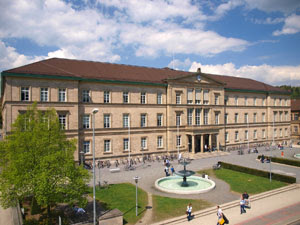Postcard 21 has travelled to TÜBINGEN!
 |
| Tübingen Altstadt from the Stiftskirche bell tower.Wikipedia |
WHERE IS TÜBINGEN?
Tübingen is a traditional university town in central Baden-Württemberg, Germany. It is situated 30 km (19 mi) south of the state capital, Stuttgart, on a ridge between the Neckar and Ammer rivers.
 |
| Location of Germany. Wikipedia |
 |
| Location of Tübingen. Wikipedia |
TÜBINGEN IS FAMOUS FOR...
... its University. It is one of Germany's most famous and oldest universities, noted in medicine, natural sciences, and the humanities. In the area of German Studies (German: Germanistik) it has been ranked first among all German universities for many years, and is known as a centre for the study of theology and religion.
 |
| University of Tübingen. University of Mannheim.com |
...the poet Hölderlin (1770-1843), who was a major German lyric poet, commonly associated with the artistic movement known as Romanticism.
 |
| Friedrich Hölderlin. Wikipedia |
PLACES TO VISIT
The Marketplace
 |
| Tübingen Marketplace. Tuebingen Info.de |
The Marketplace is known as the "living room" of Tübingen, in part because the tall homes enclosing the square – most of which were built in the 15th and 16th century – give it a cosy atmosphere.
The Marketplace was first mentioned by merchants in 1191 and in writing in 1302. The Renaissance fountain, featuring Neptune with his trident, was created in 1617 by Georg Müller.
The Granary (Fruchtkasten)
 |
| The Granary. Tueningen Info.de |
The granary is an imposing half-timbered building that was used to store the public food reserves shortly before the university was founded in 1475-76. Grain reserves were stored in the several stories of the attic. The wine presses were housed in the enormous hall on the first floor, which is over 28 m (92 feet) long and 18 m (59 feet) wide. Starting in the 19th century, the building was used as a warehouse, a building yard, a hop kiln, and a school.
The City Hall
 |
| City Hall. Tuebingen Info.de |
The oldest building in the Marketplace is City Hall, which dates back to 1435. In 1508, an additional floor was added to the original two-story structure. It was in this phase of expansion that the astronomical clock of Johannes Stöffler, a Tübingen math and astronomy professor, was added to the building.
Hohentübingen Castle
 |
| Hohetübingen Castle. Tuebingen Info.de |
At 372 m the Spitzberg (also known as the Schlossberg or castle mountain) offers a magnificent view of the Neckar and Ammer Valleys. Atop the Spitzberg, the Hohentübingen Castle, a mighty renaissance construction with four wings and a round tower, rises above the city.
Hölderlin Tower
 |
| Hölderlin Tower. Tueningen Info.de |
Located on the northern bank of the Neckar River is Hölderlin Tower – the emblem of Tübingen. The yellow tower with the pointed roof is flanked by a weeping willow and in the summer the Stocherkähne (punts) dock below it. The tower was built in the late 18th century on the base of an old tower that was part of the city fortification.. The path from the Neckar Bridge to Hölderlin Tower leads over the “Zwingen”, or the space between the inner and outer city walls of the city. The tower is named after the poet Friedrich Hölderlin (1770 – 1843), who lived in the tower from 1807 to his death on June 7, 1843.
LIFESTYLE
Steep steps, narrow lanes and pointed gabled houses dominate the townscape from the old quarter all the way up to the castle. The lovingly restored medieval town centre, the bustling streets and the studenty vibe add plenty of character, and this is complemented by all the shops, pavement cafés, wine taverns, student bars, restaurants and inns. There is always something going on in Tübingen, hardly a surprise considering the 28,500 students that live in the town.
Sources:
No comments:
Post a Comment